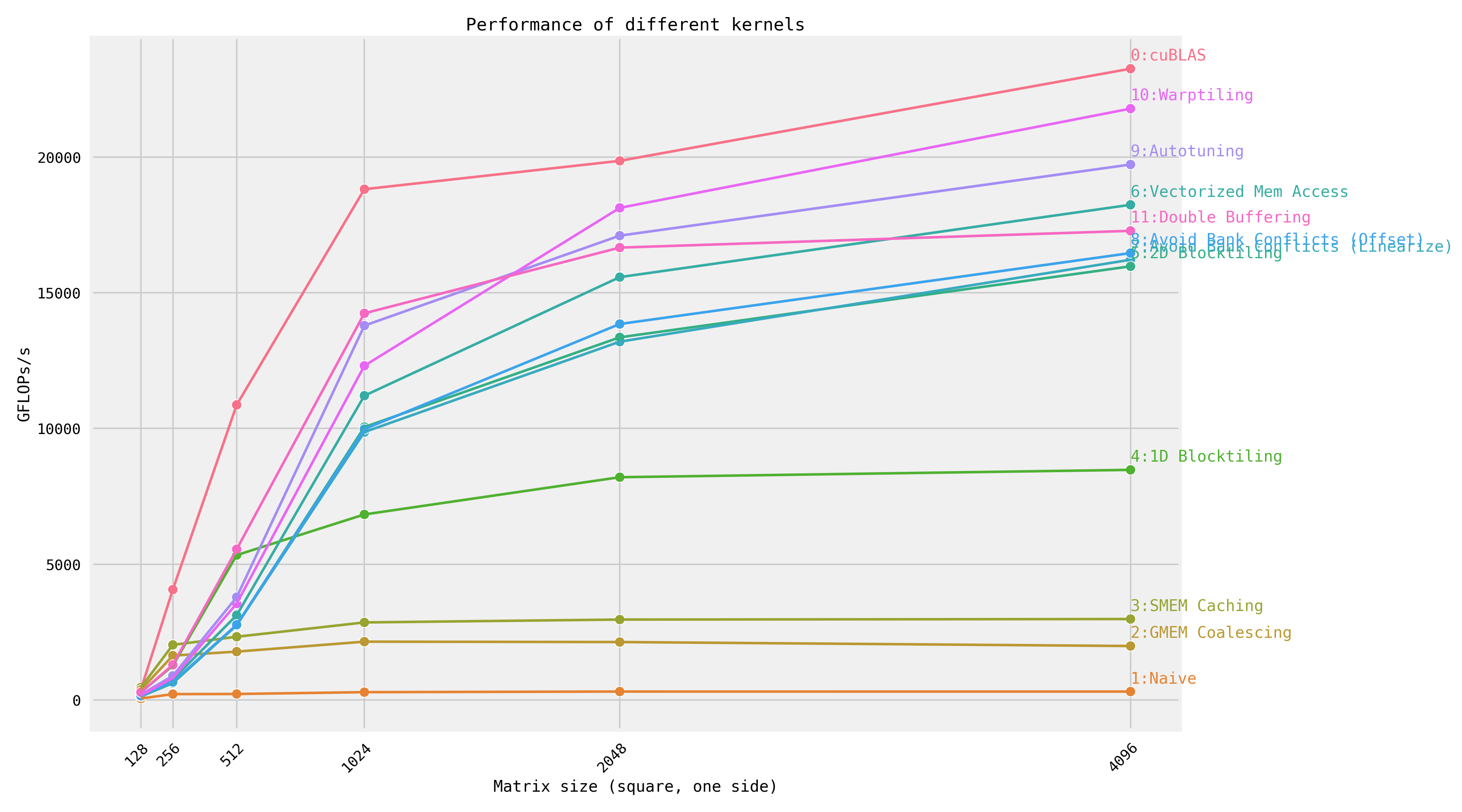I have added one new 30-line CUDA kernel to the SGEMM_CUDA project by Simon Boehm, which compares TFLOPS of various kernels doing single precision matrix multiplication.
The new kernel is often faster (on this benchmark) than the standard float32 matrix multiplication from the cuBLAS library, for example:
- 43% faster when multiplying matrices of size 12288² on an A100 GPU
- 24% faster when multiplying matrices of size 12288² on a 4090 GPU
- 23% faster when multiplying matrices of size 4096² on a H100 GPU
- 11% faster when multiplying matrices of size 8192² on a H100 GPU
How to run it:
Modify CUDA_COMPUTE_CAPABILITY in CMakeLists.txt, if needed.
Modify the variable SIZE in sgemm.cu
mkdir build && cd build && cmake .. && cmake --build .
./sgemm 0
runs the function cublasGemmEx() 50 times.
./sgemm 13
runs my new kernel sgemmZeroRegisters() 50 times.
On a 4090 GPU, the average of 20 runs of SGEMM_CUDA:
size tflops_cublas tflops_my diff
16384² 53.6 66.7 +24%
12288² 53.7 66.7 +24%
9216² 53.5 62.6 +17%
8704² 52.7 61.0 +16%
8448² 53.5 64.1 +20%
8192² 56.3-56.5 67.1 +19%
7936² 54.3 63.6 +17%
7680² 53.4 60.0 +10%
7168² 54.7 59.3 +8%
6144² 55.3 59.8 +8%
5120² 51.9 50.3 -3%
4096² 50.8-50.9 61.8 +21%
3840² 48.3 54.8 +13%
3584² 42.2 48.9 +16%
On other GPUs:
size tflops_cublas tflops_my diff gpu
12288² 51.4 56.3 +9% h100
8192² 50.5 56.1 +11% h100
4096² 43.8 53.9 +23% h100
12288² 18.9 27.0 +43% a100
8192² 19.0 26.3 +38% a100
4096² 17.5 19.8 +13% a100
8192² 27.7-28.2 33.5 +19-21% 4070ts
4096² 28.7-28.8 32.5 +13% 4070ts
16384² 28.8 34.9 +21% 3090ti
12288² 28.8 34.5 +20% 3090ti
8192² 29.3 33.3 +14% 3090ti
4096² 27.9 26.7 -4% 3090ti
4096² 9.9-10.0 10.1-10.2 +1-2% 1080ti
4096² 3.8-4.3 6.7 +56-76% T4
The average TFLOPS values were calculated using:
for i in $(seq 1 20); do ./sgemm 0; done | grep -o 'performance[^)]*' | grep -o '[^(]*$' | awk '{a=a+$1;cnt=cnt+1}END{print(a/cnt)}'
The matrix size is hardcoded as 4096 in sgemm.cu
Performance may vary with hardware configuration and software versions. I used CUDA 11.8.
How the new kernel works:
the code is straightforward and similar to other kernels in the original repository. The only trick is what I call "triggering compilation to using zero registers". The GPU has a limit of 65536 4-byte registers per block. With 512 threads per block, that gives 65536/512 = 128 registers per thread. Every thread calculates simultaneously 128 values, accumulating each value in one register. That leaves 0 registers for the actual operation of the kernel. Yet the code somehow compiles to a correctly working kernel.
Arek Paterek
The description of the original SGEMM_CUDA:
Step-by-step optimization of matrix multiplication, implemented in CUDA. For an explanation of each kernel, see siboehm.com/CUDA-MMM.
Running the kernels on a NVIDIA A6000 (Ampere):
GFLOPs at matrix size 4096x4096:
| Kernel | GFLOPs/s | Performance relative to cuBLAS |
|---|---|---|
| 1: Naive | 309.0 |
1.3% |
| 2: GMEM Coalescing | 1986.5 |
8.5% |
| 3: SMEM Caching | 2980.3 |
12.8% |
| 4: 1D Blocktiling | 8474.7 |
36.5% |
| 5: 2D Blocktiling | 15971.7 |
68.7% |
| 7: Avoid Bank Conflicts (Linearize) | 16213.4 |
69.7% |
| 8: Avoid Bank Conflicts (Offset) | 16459.2 |
70.8% |
| 11: Double Buffering | 17278.3 |
74.3% |
| 6: Vectorized Mem Access | 18237.3 |
78.4% |
| 9: Autotuning | 19721.0 |
84.8% |
| 10: Warptiling | 21779.3 |
93.7% |
| 0: cuBLAS | 23249.6 |
100.0% |
- Install dependencies: CUDA toolkit 12, Python (+ Seaborn), CMake, Ninja. See environment.yml.
- Configure NVCC compilation parameters. Look up your GPUs compute
capability here. Then configure the
CMakeLists.txtand change:set(CUDA_COMPUTE_CAPABILITY 80) - Build:
mkdir build && cd build && cmake .. && cmake --build . - Run one of the kernels:
DEVICE=<device_id> ./sgemm <kernel number> - Profiling via NVIDIA Nsight Compute (ncu):
make profile KERNEL=<kernel number>
Credit goes to wangzyon/NVIDIA_SGEMM_PRACTICE for the benchmarking setup.
